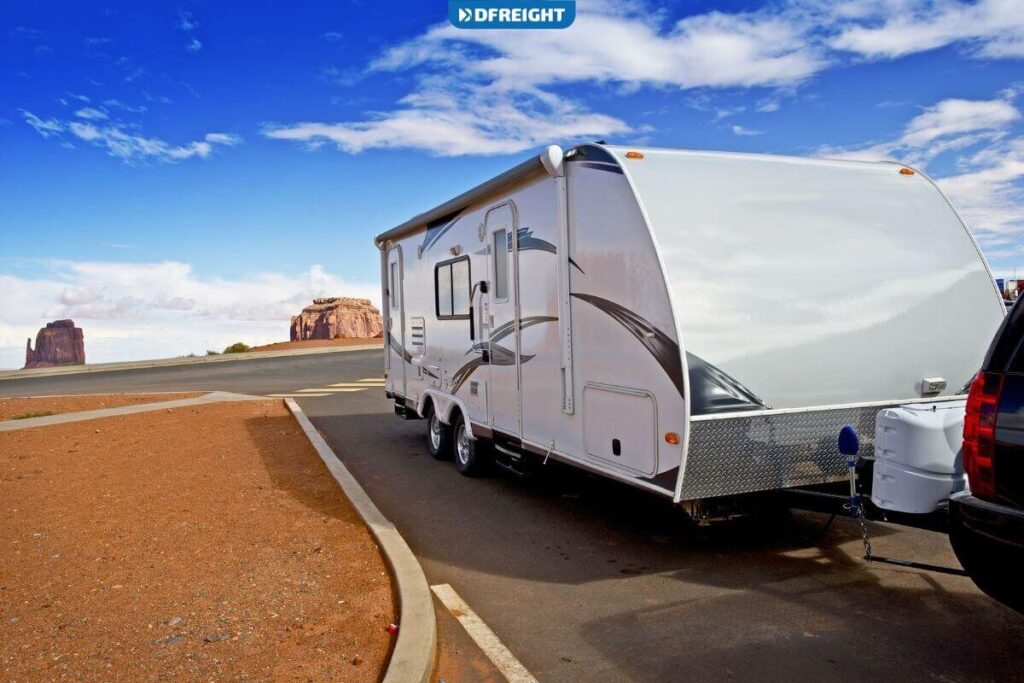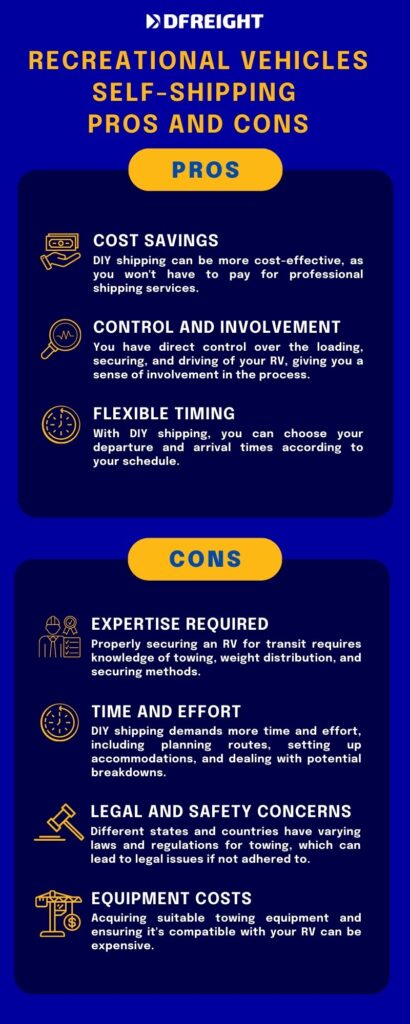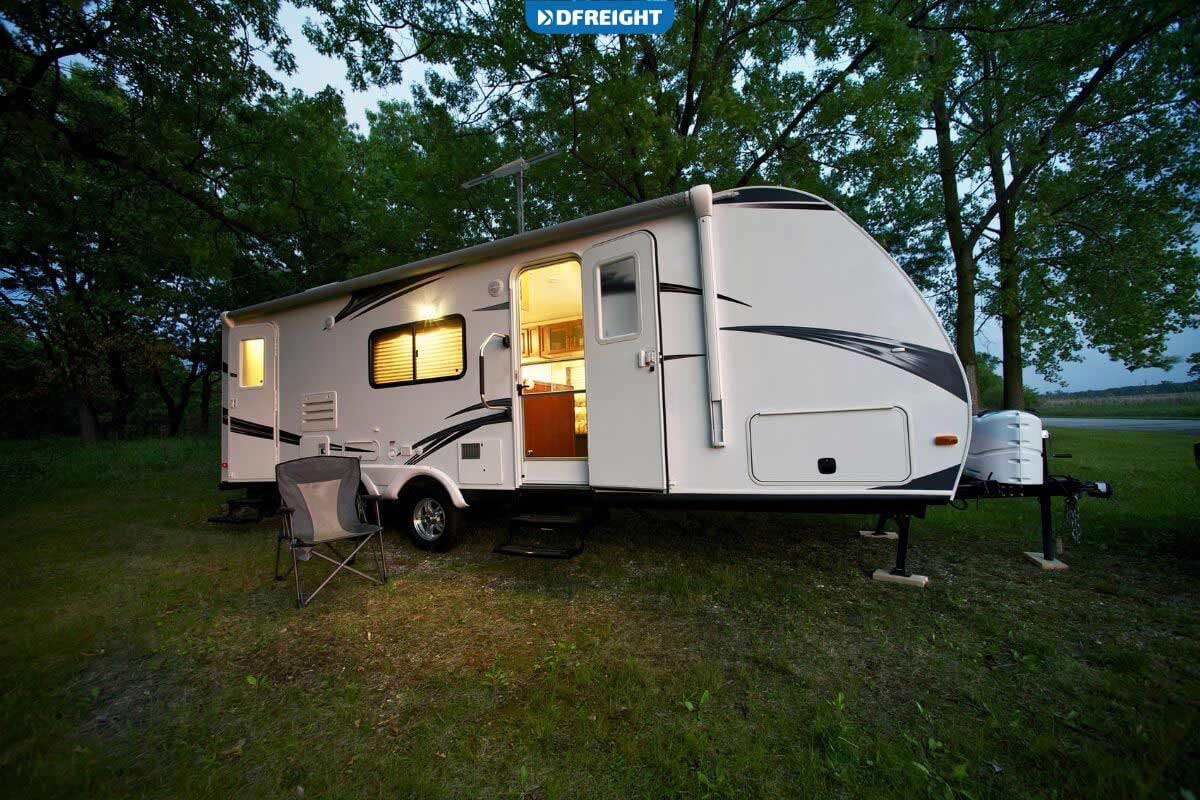Embarking on a journey in your cherished recreational vehicle (RV) is a unique and fulfilling experience, offering freedom and adventure on the open road. However, there are times when circumstances necessitate moving your home-on-wheels from one location to another without driving it yourself. Whether you’re relocating, selling, or simply seeking to explore a new destination, the process of shipping an RV comes with its own set of considerations and decisions.
This blog post is your comprehensive guide to understanding the ins and outs of shipping recreational vehicles. We’ll cover everything from the various types of RVs to choosing the right shipping method, preparing your RV for transport, selecting a reputable shipping company, managing costs, and ensuring a smooth arrival at your destination. Whether you’re a seasoned RV enthusiast or a newcomer to the world of road travel, this guide will equip you with the knowledge needed to navigate the process of shipping your treasured home away from home.
When it comes to shipping your valuable cargo, experience matters. At DFreight, we bring years of expertise as a trusted freight forwarder, ensuring your shipments reach their destination seamlessly and on time. With our extensive network, cutting-edge technology, and dedicated team, we’re committed to providing top-notch logistics solutions tailored to your needs.
Table of Contents
Types of Recreational Vehicles: Exploring Variety on Wheels
Recreational vehicles (RVs) come in a captivating array of shapes and sizes, offering a home away from home for adventurers of all kinds. From compact campers to spacious motorhomes, each RV type boasts its own unique features and benefits. As you consider shipping your cherished RV, it’s essential to understand the distinct characteristics and special considerations associated with different types.
Overview of Different RV Types and Sizes
- Motorhomes: These all-in-one vehicles are essentially homes on wheels. They include Class A, Class B, and Class C motorhomes, each varying in size and amenities. Class A motorhomes are large, luxurious coaches often equipped with full-sized appliances and high-end features. Class B motorhomes, or camper vans, are more compact and versatile. Class C motorhomes strike a balance between the two, providing comfort and functionality.
- Travel Trailers: Ranging from teardrop trailers to fifth-wheel trailers, these RVs are towed by a separate vehicle. Teardrop trailers are cozy and compact, ideal for solo travelers or couples. Fifth-wheel trailers are larger and offer spacious living areas, often with multiple bedrooms and slide-outs for additional space.
- Pop-Up Campers: Also known as tent trailers, pop-up campers are collapsible units that can be towed and expanded at the campsite. They provide a comfortable shelter while retaining the feeling of outdoor camping.
- Truck Campers: These RVs are loaded onto the bed of a pickup truck. They’re versatile, compact, and great for off-road adventures. Truck campers often feature sleeping quarters, a kitchen, and a small bathroom.
- Toy Haulers: Perfect for those who want to bring recreational vehicles like ATVs, motorcycles, or bicycles, toy haulers combine living space with a built-in garage in the rear.

Special Considerations for Shipping
When it comes to shipping RVs, different types require distinct handling and precautions:
- Motorhomes: Due to their size and weight, motorhomes may require specialized transport methods such as flatbed trucks or enclosed carriers. Adequate securing of interior items is crucial to prevent shifting during transport.
- Travel Trailers: Fifth-wheel trailers often require a compatible transport hitch, while smaller travel trailers can be towed using standard equipment. Both types should be carefully loaded and secured to prevent movement.
- Pop-Up Campers and Truck Campers: These RVs need proper securing to prevent damage to the folding mechanisms during transit. Roof and canvas protection is essential to safeguard against weather elements.
- Toy Haulers: Emptying the garage space of toy haulers and securing any loose items is crucial. Ensure the garage area is well-protected during transport to prevent damage to the interior and cargo.
Understanding the nuances of different RV types and their shipping requirements ensures a successful shipping experience. As you embark on the journey to transport your cherished RV, remember these considerations to make the process as smooth and stress-free as possible.
Choosing a Shipping Method: Open vs. Enclosed Transport for Your RV
When it comes to shipping your beloved recreational vehicle (RV), selecting the right shipping method is a crucial decision. The choice between open and enclosed transport plays a significant role in safeguarding your RV during transit and ensuring it arrives at its destination in the best possible condition. Let’s explore the pros and cons of both options and help you make an informed choice.
| Pros | Cons |
| Cost-Effectiveness: Open transport is generally more affordable than enclosed transport, making it an attractive option for budget-conscious individuals. | Exposure to Elements: The biggest drawback of open transport is exposure to weather conditions, road debris, and environmental factors that could potentially cause damage to your RV. |
| Wide Availability: Open carriers are more common, resulting in greater availability and potentially shorter waiting times for shipping. | Limited Protection: While some carriers have top covers, your RV is still exposed to the sides and rear, leaving it vulnerable to dirt, dust, and debris. |
| Visibility: With your RV in plain view, open transport allows for easy visual inspection of the vehicle during transit. |
| Pros | Cons |
| Superior Protection: Enclosed transport offers higher protection against weather elements, road debris, and potential damage caused by external factors. | Higher Cost: Enclosed transport is generally more expensive due to the added level of protection and security it offers. |
| Security: Enclosed carriers often provide increased security measures, reducing the risk of theft or vandalism during transit. | Limited Availability: Enclosed carriers are less common, which could result in longer waiting times for shipping. |
| Less Wear and Tear: With your RV sheltered from the elements, there’s less chance of wear and tear caused by exposure to wind, rain, and UV rays. |
Selecting the Appropriate Shipping Mode for Your RV
The choice between open and enclosed transport depends on various factors, including your budget, the value of your RV, and your comfort level with potential exposure during transit. Here’s how to decide:
- Consider RV Value: If your RV is a high-value, luxury, or vintage model, the added protection of enclosed transport might be worth the higher cost.
- Weather and Distance: If you’re shipping through harsh weather conditions or across long distances, enclosed transport can offer peace of mind.
- Personal Preference: If preserving the pristine condition of your RV is a top priority, even for a standard model, enclosed transport is a reliable choice.
- Budget Consideration: Open transport might be suitable if you’re looking for a more economical option and your RV can withstand exposure.
- Timing: Assess how quickly you need your RV delivered. If time is of the essence, open transport might offer more flexibility in scheduling.
In the end, the decision between open and enclosed transport should align with your priorities, budget, and the value you place on protecting your RV. Whichever method you choose, taking the time to make an informed decision ensures a successful and worry-free shipping experience for your cherished RV.
Preparing Your RV for Shipping: Ensuring a Smooth Journey
As you embark on the journey of shipping your cherished recreational vehicle (RV), proper preparation plays a pivotal role in ensuring its safe and successful transit. Preparing your RV adequately protects it from potential damage during shipping and makes the entire process smoother for you and the shipping company. Here’s a comprehensive guide to getting your RV ready for its upcoming voyage.
Cleaning and Inspection Checklist
- Exterior Cleaning: Thoroughly clean the exterior of your RV to remove dirt, grime, and road debris. This helps with inspection and prevents contaminants from causing damage during transport.
- Interior Cleaning: Clean the interior to prevent mold, odors, and pests during transit. Vacuum carpets, wipe surfaces, and ensure cabinets are securely closed.
- Inspection: Conduct a detailed inspection of your RV’s exterior and interior. Document any existing damage or issues with photographs and notes. This will serve as a reference in case of any discrepancies upon arrival.
Securing Loose Items and Removing Personal Belongings
- Secure Interior Items: Remove any loose items that could shift during transit and cause damage. Secure appliances, dishes, decor, and other loose objects.
- Remove Valuables: Take out personal items, valuables, and important documents from the RV. This reduces the risk of loss or damage during shipping.
- Retract Slides and Awnings: If your RV has slide-outs or retractable awnings, ensure they are properly retracted and secured.
Handling Fuel, Propane, and Battery Considerations
- Fuel Level: For safety reasons, most shipping companies require your RV’s fuel tank to be at a quarter full or less. This reduces the weight and minimizes the risk associated with transporting flammable liquids.
- Propane Tanks: Propane tanks must be turned off and securely fastened in place. Detachable tanks should be removed and stored properly.
- Batteries: Disconnect the RV’s batteries to prevent accidental draining during transit. This is especially important for longer journeys.
- Tire Pressure: Ensure that your RV’s tires are properly inflated. Correct tire pressure helps prevent damage to the tires and suspension during transport.
- Fluids: Check all fluid levels and ensure they are within the recommended ranges. This includes engine oil, coolant, transmission fluid, and brake fluid.
- Windows and Vents: Close and secure all windows and roof vents to prevent dust, dirt, and moisture from entering during transit.
- Antennas and Accessories: Lower or secure any external antennas, satellite dishes, or accessories that could be damaged by low clearance areas or wind resistance.
By meticulously following these preparation steps, you’ll be well on your way to a smooth and stress-free RV shipping experience. Taking the time to prepare your RV for its journey demonstrates your commitment to ensuring its safety and that it arrives at its destination in the best possible condition.
Hiring a Professional Company for Shipping Recreational Vehicles
When it comes to entrusting your cherished recreational vehicle (RV) to a shipping company, making the right choice is paramount. The process of shipping an RV requires careful consideration of various factors to ensure a seamless and stress-free experience. From researching and comparing services to verifying insurance and licensing, here’s how to find a professional RV shipping company you can rely on.
Researching and Comparing Shipping Services
- Start with Online Research: Begin by searching for reputable RV shipping companies online. Look for companies with a solid online presence, informative websites, and a history of positive customer reviews.
- Check Company Credentials: Verify the company’s credentials, including its years of experience in RV shipping, affiliations with industry organizations, and any awards or recognitions.
- Service Specialization: Some companies may specialize in certain types of RVs or shipping routes. Choose a company that has experience in handling your specific RV type and the route you need.
- Customer Reviews: Browse online reviews and testimonials from past clients. Pay attention to feedback about communication, timeliness, and overall satisfaction.

Reading Reviews and Requesting Quotes
- Customer Testimonials: Read positive and negative reviews for a well-rounded company performance perspective. Look for patterns in the feedback to identify potential strengths and weaknesses.
- Request Multiple Quotes: Contact several RV shipping companies to obtain quotes. Provide accurate information about your RV, the distance, and any specific requirements you have.
- Detailed Quotes: Ensure that the quotes you receive are detailed and transparent. They should include all relevant costs, potential fees, and any extra services offered.
- Compare Services and Costs: While cost is important, don’t solely base your decision on the lowest price. Consider the level of service, reputation, and the company’s ability to address your specific needs.
Verifying Insurance and Licensing
- Insurance Coverage: Confirm that the RV shipping company carries appropriate insurance coverage to protect your RV in case of damage or loss during transit.
- Licensing and Credentials: Check the company’s licensing and registration. They should possess the licenses and authority to operate as freight carriers.
- Bonding: Inquire about bonding, which provides additional financial security in case the company fails to fulfill its obligations.
- Regulatory Compliance: Make sure the company adheres to federal and state regulations governing the transport of vehicles, especially for interstate and international shipping.
- Communication: A professional RV shipping company will be transparent in sharing insurance and licensing information and will promptly address any concerns you have.
By diligently researching, comparing services, and verifying essential details, you can select a professional RV shipping company that aligns with your requirements and provides the peace of mind you need throughout the shipping process. Remember that your RV is not just a vehicle but a valued possession; entrusting it to a reliable and competent shipping partner is paramount.
Cost Factors in RV Shipping: Navigating the Financial Aspects
Shipping your beloved recreational vehicle (RV) involves careful planning and understanding the various cost factors associated with the process. From the distance and destination to the size and weight of your RV and additional fees and services, a clear understanding of these cost considerations will help you budget effectively and make informed decisions for a successful shipping experience.
Distance, Destination, and Route Considerations
- Travel Distance: Your RV’s travel distance directly impacts the shipping cost. Longer distances generally lead to higher costs due to fuel, labor, and time required for transport.
- Destination: Shipping to remote or less accessible locations may result in higher costs due to limited carrier availability and potentially challenging routes.
- Route Complexity: If your RV’s route involves challenging terrain, tolls, or areas with traffic restrictions, the shipping company might need to take detours, affecting the overall cost.
RV Size, Weight, and Dimensions Impacting Shipping Costs
- Size and Weight: Larger and heavier RVs typically incur higher shipping costs due to the increased demand for transport resources and fuel consumption.
- Dimensions: Unusually large dimensions, such as extra height or width, may require special permits or escorts, adding to the shipping expenses.
Additional Fees and Services to Budget For
- Type of Service: The choice between open and enclosed transport affects the cost. Enclosed transport is generally more expensive due to the enhanced protection it offers.
- Urgency and Season: If you need expedited shipping or are shipping during peak travel seasons, such as summer, the cost might be higher due to increased demand.
- Pickup and Delivery Locations: The accessibility of the pickup and delivery locations plays a role in cost. Locations with limited access or challenging terrain may incur extra charges.
- Insurance: While reputable shipping companies have insurance coverage, additional insurance options might be available for added peace of mind.
- Special Handling: There could be additional charges if your RV requires specialized handling, such as delicate antiques or oversized equipment.
- Customization and Modifications: If your RV has non-standard modifications or accessories that affect its dimensions, these may result in extra fees.
- Storage: Storage fees might apply if there are delays in pickup or delivery.
Budgeting Tips
- Obtain Multiple Quotes: Request quotes from several RV shipping companies to compare costs and services.
- Plan Ahead: Booking well in advance can potentially lead to lower rates and more availability.
- Pack Wisely: Remove excess weight, secure loose items, and minimize modifications that could affect dimensions.
- Understand the Quote: Ensure the quotes you receive are detailed and transparent, outlining all costs and potential fees.
- Communication: Discuss your needs and concerns with the shipping company to understand the cost breakdown.
As you plan your RV shipping journey, keeping these cost factors in mind will empower you to budget effectively and make informed decisions. Remember that while cost is important, the safety and reliability of the shipping company should also be top priorities to ensure a successful and stress-free shipping experience for your treasured RV.
Documentation and Legalities: Navigating the Paperwork of RV Shipping
When it comes to shipping your cherished recreational vehicle (RV), proper documentation and legal compliance are essential to a smooth and successful shipping experience. Understanding the necessary paperwork and legal requirements, from title and registration to crossing international borders. Let’s explore the key aspects of documentation and legalities in the realm of RV shipping.
Title, Registration, and Documentation Requirements
- Vehicle Title: Before shipping your RV, ensure you have a valid and current title in your name. The title establishes your ownership of the vehicle.
- Vehicle Registration: Make sure your RV is registered and the registration is current. This documentation verifies that your RV is legally allowed to be on the road.
- Proof of Insurance: Provide documentation of your RV’s insurance coverage, which may be required by the shipping company and authorities.
- Bill of Sale: While not always required, a bill of sale can serve as additional proof of ownership and transaction details.
- Vehicle Identification Number (VIN): The VIN is a unique identifier for your RV. Ensure it’s accurate on all documents to prevent any discrepancies.
Crossing Borders: International RV Shipping Considerations
- Customs Regulations: When shipping an RV internationally, familiarize yourself with the destination country’s customs regulations. Some countries have specific requirements for vehicle imports.
- Import Taxes and Duties: Understand the potential import taxes, duties, and fees associated with bringing your RV into a different country. Research the cost implications and make necessary arrangements.
- Temporary Importation: Some countries allow for temporary importation of vehicles, often with a time limit. Ensure you comply with the conditions and timeframes.
- Documentation: International shipping may require additional documentation, such as a certificate of origin, emission certificates, and other country-specific requirements.
- Power Source Compatibility: Check if your RV’s power sources (such as electrical connections) are compatible with the standards of the destination country.
- Vehicle Modifications: Some countries have specific regulations regarding modifications to vehicles. Ensure that any modifications on your RV adhere to the destination country’s regulations.
Preparation Tips
- Research Early: Research the legal requirements and documentation for shipping well in advance to allow time for any necessary arrangements.
- Consult Professionals: Consult with experts specializing in customs regulations and international vehicle transport for international shipping.
- Double-Check Details: Ensure that all documentation is accurate and up to date before shipping to avoid any delays or complications.
- Language Barriers: If you’re dealing with documentation in a foreign language, consider having a translation or a local representative assist you to prevent misunderstandings.
By adhering to the proper documentation and legal requirements, you’ll ensure a smooth and compliant RV shipping process, whether it’s within your own country or across international borders. Being well-prepared with the necessary paperwork will help you navigate the legal aspects of RV shipping with confidence and peace of mind.
Safety and Security During Transit: Ensuring a Smooth Journey for Your RV
From tracking and communication to safeguarding against potential damage, understanding how to protect your RV throughout shipping will provide peace of mind and a successful shipping experience. Let’s explore the key aspects of safety and security during RV transit.
Tracking and Communication with the Shipping Company
- Real-Time Tracking: Choose a shipping company that offers real-time tracking of your RV’s journey. This allows you to monitor its progress and anticipate arrival times.
- Regular Updates: Maintain open communication with the shipping company. Inquire about their policy for updating your RV’s status, especially if unexpected delays occur.
- Emergency Contact: Ensure you have a direct contact at the shipping company who can address any concerns or questions you might have during transit.
- Confirmation of Arrival: Coordinate with the shipping company to receive confirmation once your RV has safely arrived at the destination.
Receiving Your Shipped RV
As your RV completes its journey and arrives at its destination, a few essential steps will ensure a seamless transition from shipping to road travel. From conducting a thorough inspection upon arrival to addressing any issues or concerns and reestablishing utilities and systems, this guide will help you confidently navigate the process of receiving your shipped RV.
Inspection Upon Arrival
- Scheduled Arrival: Coordinate with the shipping company to ensure you’re present when your RV arrives. Timely communication and coordination can help minimize any potential delays.
- Visual Inspection: As your RV is unloaded, visually inspect its exterior. Compare its current condition to the documentation you prepared before shipping.
- Interior Check: Once your RV is on the ground, inspect the interior for any noticeable shifts, movement, or damage. Pay close attention to items you secured before transit.
Addressing Any Issues or Concerns
- Documenting Damages: If you notice any damage or issues during the inspection, document them immediately with photographs and notes.
- Shipping Company Contact: If you discover significant damage during transit, contact the shipping company promptly to report the issue and discuss the next steps.
- Insurance Claims: If the damage is extensive, initiate the freight claim process with the shipping company as soon as possible.
Reconnecting Utilities and Systems
- Power and Batteries: If you disconnect the batteries before transit, reconnect them and ensure they’re properly charged.
- Propane and Fuel: If applicable, reconnect propane tanks and refill the fuel tank as needed.
- Water and Plumbing: Check the water system for any leaks or issues. Reconnect water hoses and ensure faucets and toilets are functioning correctly.
- Electrical Connections: Reconnect any electrical connections, ensuring all appliances and systems are operational.
- Awning and Slide Outs: If your RV has retractable awnings or slide-outs, carefully extend them and verify proper functionality.
By conducting a thorough inspection, promptly addressing any issues, and methodically reconnecting utilities and systems, you’ll ensure a smooth transition from shipping to enjoying the road in your RV. This careful approach will help you begin your journey with confidence and comfort.
DIY RV Shipping: Weighing the Pros and Cons of Self-Shipping
The idea of transporting your own recreational vehicle (RV) might seem appealing for hands-on people who prefer a level of control over the shipping process. However, embarking on a DIY RV shipping endeavor comes with its own set of considerations. Let’s explore the pros and cons of self-shipping and the necessary equipment and resources for a successful DIY RV shipping experience.

Necessary Equipment and Resources for DIY Shipping
- Towing Vehicle: Ensure your towing vehicle is equipped to handle the weight and size of your RV. Consult your vehicle’s towing capacity specifications.
- Towing Equipment: Invest in a reliable and compatible towing hitch, ball mount, safety chains, and electrical connections.
- Weight Distribution System: If your RV is a travel trailer or fifth wheel, a weight distribution system helps evenly distribute the load and enhances stability.
- Brake Controller: Ensure your towing vehicle has a brake controller installed to synchronize braking between the vehicle and RV.
- Towing Mirrors: Extended towing mirrors provide better visibility of the RV and surrounding traffic.
- Route Planning: Plan your route carefully, considering road conditions, low clearances, and potential challenges along the way.
- Accommodations: Plan ahead for overnight stays by booking RV-friendly campsites or overnight parking locations.
While DIY RV shipping offers a hands-on approach and potential cost savings, it requires careful planning, knowledge, and equipment. Before embarking on a DIY shipping journey, assess your level of expertise and comfort with towing, and consider the potential challenges that may arise. Weigh the pros and cons to determine whether DIY shipping aligns with your preferences and capabilities.
Ready to Ship with Confidence? Choose DFreight!
Experience peace of mind knowing that your freight is in capable hands. Whether it’s international shipping, specialized handling, or efficient supply chain management, DFreight has you covered every step of the way.
Get started today and discover the difference experience makes in freight forwarding. Contact us for a personalized quote, and let’s embark on a successful shipping journey together!
How much does it cost to ship an RV?
RV shipping costs vary based on distance, type of RV, transport method, and additional services.
Is my RV insured during shipping?
Reputable shipping companies offer insurance, but inquire about coverage limits and consider additional insurance options.
What’s the difference between open and enclosed transport?
Open transport exposes your RV to elements, while enclosed transport provides more protection but comes at a higher cost.
Do I need to prepare my RV before shipping?
Yes, secure loose items, disconnect batteries, propane tanks, and prepare for weather conditions.
Can I ship an RV internationally?
Yes, but it involves customs regulations, taxes, and potentially unique requirements of each country. Research is crucial.














